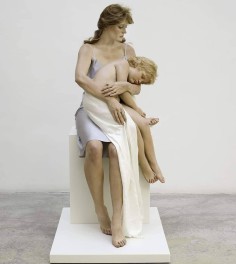john de andrea

source:britannicacom
John De Andrea, (born November 24, 1941, Denver, Colorado, U.S.), American Super-realist sculptor known for his detailed life-size female nudes depicted in naturalistic poses. He is associated with the Photo-realist and Verist art movements.
De Andrea began studying art at the University of Colorado at Boulder, where he earned a B.F.A. in 1965. He continued his studies at the University of New Mexico in Albuquerque from 1966 to 1968. Two years later, De Andrea had his first solo exhibition, at OK Harris Gallery in New York City. That was followed by his inclusion in several important group exhibitions, including “Radical Realism” at Chicago’s Museum of Contemporary Art (1971) and Documenta V (1972) and VII (1982) in Kassel, Germany.
De Andrea distinguished himself from other artists working in the hyperrealistic or Photo-realist aesthetic—Duane Hanson and George Segal—with a disinterest in social commentary. De Andrea achieved an extreme degree of detail by casting his works directly from life and then applying paint to the cast in a highly illusionist way that erased any sign of his process or materials. He focused almost exclusively on representations of individual female nudes, such as Dorothy (1969–70), Model in Repose (1981), Linda (1983), and Ariel I (2011). However, he also on occasion created multifigured works—Clothed Artist and Model (1976), for example, which shows the model partially encased in plaster and offers the viewer insight into De Andrea’s art-making process. With their flat expressions, the figures do not engage with or acknowledge the viewer.
De Andrea’s primary sculptural material was fibreglass, but he also worked with polyester resin, polyvinyl acetate, and polychrome bronze. He was known to incorporate natural hair into his pieces as well, amplifying the sense of realism. Though his subject matter stayed the same, the hyperrealistic aesthetic and nuanced posing made each sculpture unique.
.
.
.
.
.
.
.
.
source:nationalgalleriesorg
John de Andrea was born in Denver, Colorado and studied painting at the University of Colorado from 1961 to 1965. He began making fibreglass casts of parts of the body while at graduate school in New Mexico, inspired by seeing a friend using fibreglass to make kayaks. De Andrea developed his technique to make increasingly sophisticated and lifelike models, which are painstakingly painted by hand. Like the sculptures of Duane Hanson, de Andrea’s casts of female nudes are associated with the photorealist movement in sculpture and painting.
.
.
.
.
.
.
.
source:treccaniit
De Andrea, John. – Scultore statunitense (n. Denver 1941). Partendo dagli orientamenti artistici dell’iperrealismo, ha come tema privilegiato i nudi femminili, realizzati in fibra di vetro e PVC colorato. Le figure, rese in maniera quanto più possibile aderente alla realtà, mostrano un effetto di freddezza in netto contrasto con la sensualità del soggetto raffigurato. Su questo contrasto De A. ha fondato gran parte della sua poetica. Tra le sue opere: Sitting Woman (1972); Girl with clasped hands (1984); American Beauty (1986). Le sue creazioni sono esposte in diversi musei del mondo e, prevalentemente, negli Stati Uniti.
.
.
.
.
.
.
.
source:arteseanpblogspotcom
John de Andrea (1941-) Nasceu em Denver. Estudou na University of Colorado e na University of New Mexico. Um dos pioneiros da escultura hiperrealista. Discute o corpo humano, havendo predominância de nús femininos. Participou da Bienal de Veneza e da Documenta de Kassel. Vive e trabalha em Denver.
.
.
.
.
.
.
.
source:losvalientesduermensolosblogspotcom
John de Andrea (Denver, Colorado, 1941), considerado por la crítica internacional como el padre del Hiperrealismo en el campo de la escultura. Desde que esta nueva concepción artística surgiera en Estados Unidos, en la década de los años sesenta, John de Andrea ha sido calificado como el pionero y maestro tanto de generaciones posteriores como contemporáneas a él, pues todavía hoy en día ningún otro artista ha conseguido superar la calidad técnica de sus esculturas y el asombro que producen en el espectador.

